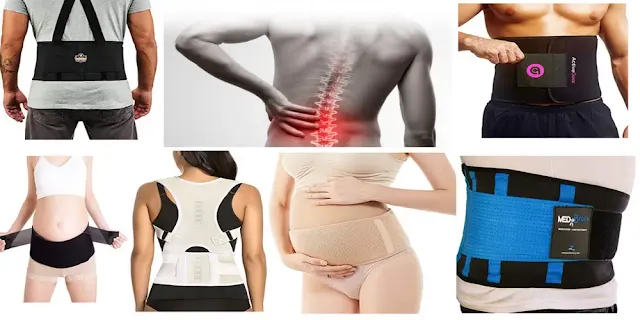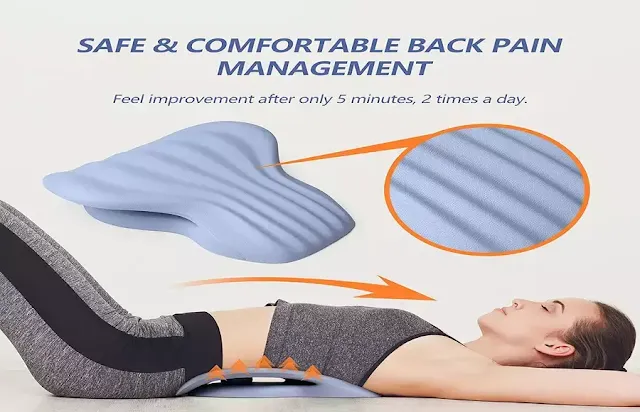How works Back Pain Belt?
Many people have questions about how back pain belts work. These devices work by reducing pressure on the spine by preventing it from bending forward and backward. The belt also covers a large area of the lower back and retains heat for a long time. It has a comfortable fur on the inner surface, which helps to retain the heat and distribute it evenly. It is also controlled by buttons connected to a wire.
If you have back pain, it is important to consult with a doctor. Wearing a back support belt may help relieve pain, but it cannot replace proper physical therapy. It is best used with a back specialist. They can diagnose the cause of the pain and recommend proper treatment. In some cases, wearing a back support belt can make back pain worse.
A back pain belt helps to alleviate the pain caused by back aches and pains. It can be used as an adjunctive treatment for acute injuries, as well as for preventing further damage. While rest and ice/cold applications are typical recommendations for acute injuries, support is essential for allowing the impaired tissues to heal. Compression is also an effective treatment for acute injuries because it helps to minimize inflammation and increase circulation which improves healing.
- Back support belts
Back support belts have been shown to help reduce the pain in the back. They can also help you recover more quickly after an injury. They can also help you continue to do activities that you otherwise would not be able to do because of back pain. Back support belts work by compressing muscles and suspensory ligaments to help relieve pain and help you maintain a proper posture.
Unlike traditional back braces, back support belts provide support and stability to the spine and abdomen. They also improve posture, which makes it easier to return to work after an injury. Some back support belts also feature heating and massage elements. Some may even be breathable, which may reduce skin irritation. However, make sure you choose the right one for your body type and the type of back pain you suffer from.
Back support belts are also beneficial for people who do a lot of heavy lifting. They offer extra support to the back, and they can be comfortable to wear for long periods of time. The best ones are designed to help people with moderate to severe pain with lifting. However, it's important to remember that when you are in pain, you should never lift anything that causes pain.
Back braces and back support belts are common for people with chronic back pain. These braces provide extra support to reduce muscle tension while lifting, and help people maintain proper posture. They can also prevent back injuries because they encourage proper form. Additionally, back braces are recommended for those who have spinal surgery or are told to limit movement when lifting.
- Mechanisms of action
Back pain belts are designed to protect the lower back by applying pressure against the abdominal wall during exertion. This increased pressure is thought to help stabilize the spine. However, this effect may not be universal. Different movements may require different amounts of force. So, the effectiveness of back pain belts can vary.
The Working Group concluded that the effectiveness of back pain belts depends on a number of factors. Insufficient evidence was found to support the use of back pain belts in preventing low back injuries. One major weakness of the study was that it used self-reported data. The lack of objective data meant that recall bias was likely to be introduced.
There are several theories explaining the effectiveness of back pain belts. One hypothesis proposes that back pain belts may reduce intraabdominal pressure (IAP) and spinal compression (IAP). However, no studies have verified this hypothesis. This theory may be flawed, as it is based on many assumptions.
Other studies have shown that back pain belts can reduce spinal compression. However, these studies are limited to therapeutic lumbar orthoses and have not been tested for industrial-style back pain belts. The study also has a small sample size, which makes it difficult to generalize its findings to industrial-type back pain belts.
- Preparation
Before you begin your journey towards the use of a back pain belt, you should know a little bit about it. Back pain can be a debilitating condition. By wearing a back support, you can make every day activities less painful and increase your quality of life. In addition to providing you with pain relief, these belts are also useful in the event of an accident.
While back support belts can help reduce the pain in the lower back, they can't help fix the underlying problem. You should first see a spine specialist to determine the exact cause of your back pain and what treatments are appropriate for you. For instance, you should consider if you'll be using your back pain belt in a certain activity, such as running or swimming.
While many people find them helpful, there's still some debate about their effectiveness. Although they don't have much clinical evidence to back their claims, there's no denying that back belts may be helpful. In fact, research has suggested that they can significantly reduce muscle fatigue and biomechanical strain, improve posture, and increase a person's sense of safety. But the question is whether they actually work and whether they're effective enough to replace an overall ergonomics program.
One back pain support belt is a back brace that corrects your posture when you bend forward. This belt helps you relax your rectus femoris muscles and moves your pelvis posteriorly, reducing the strain on your low back. It also encourages you to engage your trunk muscles, which increases low back stability. This is important for more efficient low back rehabilitation exercises and for maintaining the results of chiropractic care. It can also help you avoid experiencing low back pain when doing physical work.
- Safety
There is some controversy about the safety of back pain belts. While they may provide protection for the lower back, there are no studies that have proven they reduce back injuries. The theory behind the belt is that they reduce spinal compression by applying pressure against the abdominal wall during exertion. This may reduce the risk of disc injuries and increase the stability of the spine, but it is unclear whether back belts have the same effect on every type of movement.
Back injuries are among the most expensive and common workplace injuries. According to the National Safety Council, the average cost of a back injury is almost $40,000. Some organizations have tried implementing back belts to help prevent back injuries. However, research by the National Institute for Occupational Safety and Health indicates that back pain belts do not reduce the incidence of back injuries.
The Centers for Disease Control and Prevention (CDC) and the National Institute of Occupational Safety and Health (NIOSH) reviewed published studies to determine whether back pain belts reduce back injuries. However, most studies were based on theories and not on actual rates of back injuries in the workplace. A more thorough research is needed to determine the safety of back pain belts.
While back pain belts have been linked to reduced workplace injuries, no definitive proof has been provided. These devices are used as adjuncts to other interventions such as ergonomic awareness programs and training. Back belts were initially used in medical settings. Often called orthoses (after their Victorian name), back belts provided additional support for injured people while they recovered from an injury. Later, athletes began using leather belts while weight lifting.
How to choose the best Back Pain Belt
If you're looking for a back pain belt, there are many different types and styles to choose from. These back support belts are an excellent option for people with sports injuries, disc injuries, and other types of back pain. They can be used for both minor and severe pain and are comfortable to wear for long periods.
Back pain belts can also be used to help with posture. Some of the best are elastic and double stitched for extra grip and support. You can wear them over your clothes or underneath your clothing for added support. You'll find that these back pain relief belts come in sizes ranging from extra small to extra large. These back support belts can provide pain relief and help you maintain your posture while walking, sitting, or bending over.
A double strap back support belt is an excellent choice if you're experiencing mild back pain. The elastic is ventilated to prevent sweat from collecting on the inner surface. It also has a double pull mechanism and a large hook loop. It's comfortable to wear and comes in a variety of sizes, so you can find one that suits your body type.
- Buy Back Pain Belt
If you are looking to Buy Back Pain Belt in Pakistan, Amazon can be a great choice. Its online store is easy to navigate and its cash on delivery option makes the process even easier. Here are some of the best options to consider when buying a back pain belt in Pakistan: Let's start with a lightweight adjustable back pain belt. Its stainless steel material ensures durability and comfort, and its two adjustable straps allow it to be securely tied around your waist.
To Buy CLICK HERE OR Tab on Below Image
Final Opinion:
There are many factors to consider when selecting a back pain belt. Some models are designed for specific types of activities, while others are adjustable to accommodate a variety of body shapes. While some studies show some benefits of wearing a back support belt, more research is needed to determine if it is an effective treatment.
First, it is important to note that wearing a back support belt is not a replacement for physical therapy. Some people may experience temporary relief while wearing one, but this is only true for a short period. For long-term results, you should consult with a spine specialist. Only a spine specialist can diagnose your problem and recommend appropriate treatment.
The use of a back support belt may cause muscle atrophy, which may set you up for injury. The belt may also restrict motion, which puts additional strain on other muscles. This could lead to injuries elsewhere. Further, it may cause digestive issues and increase blood pressure and resting heart rate.


